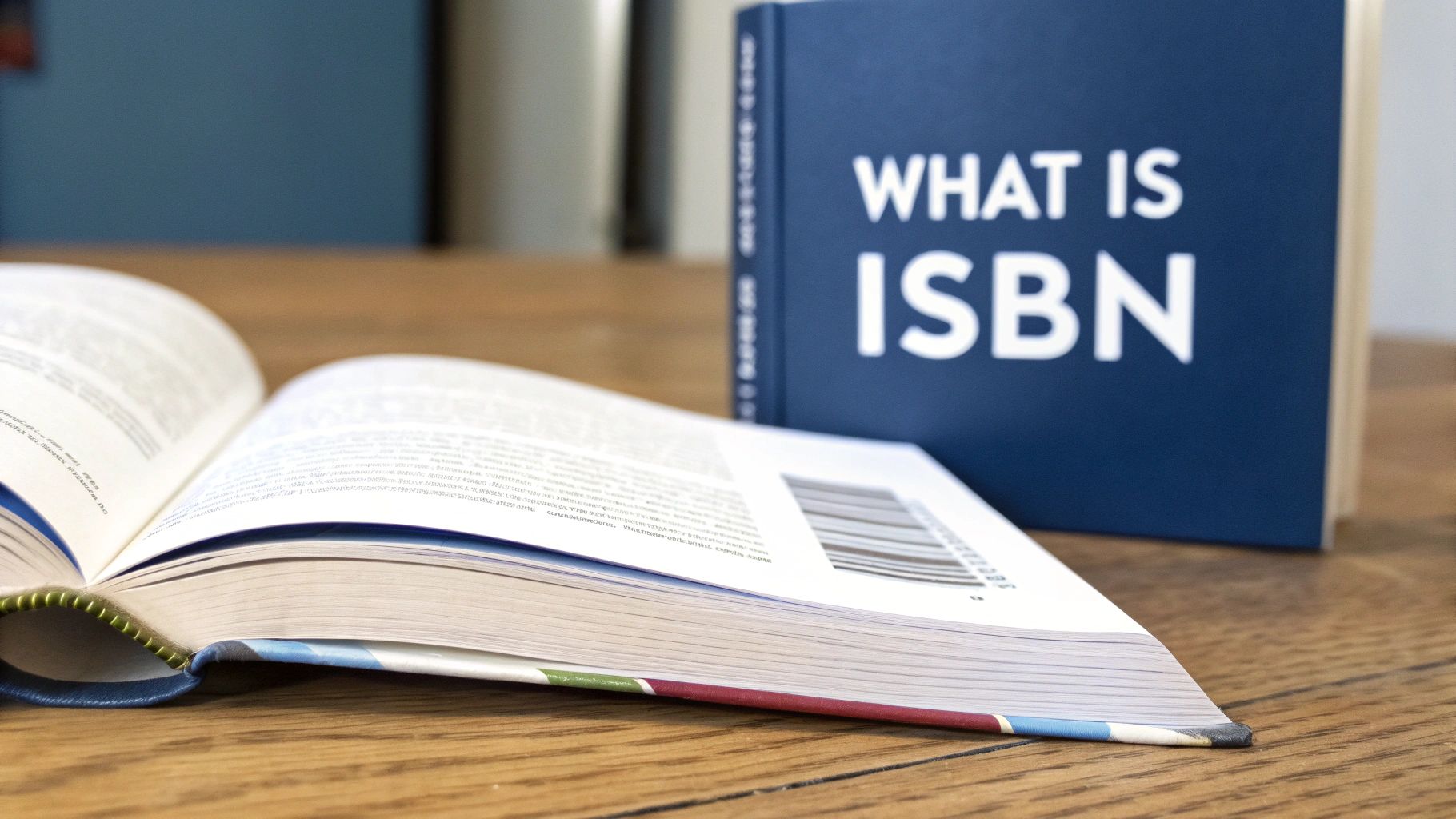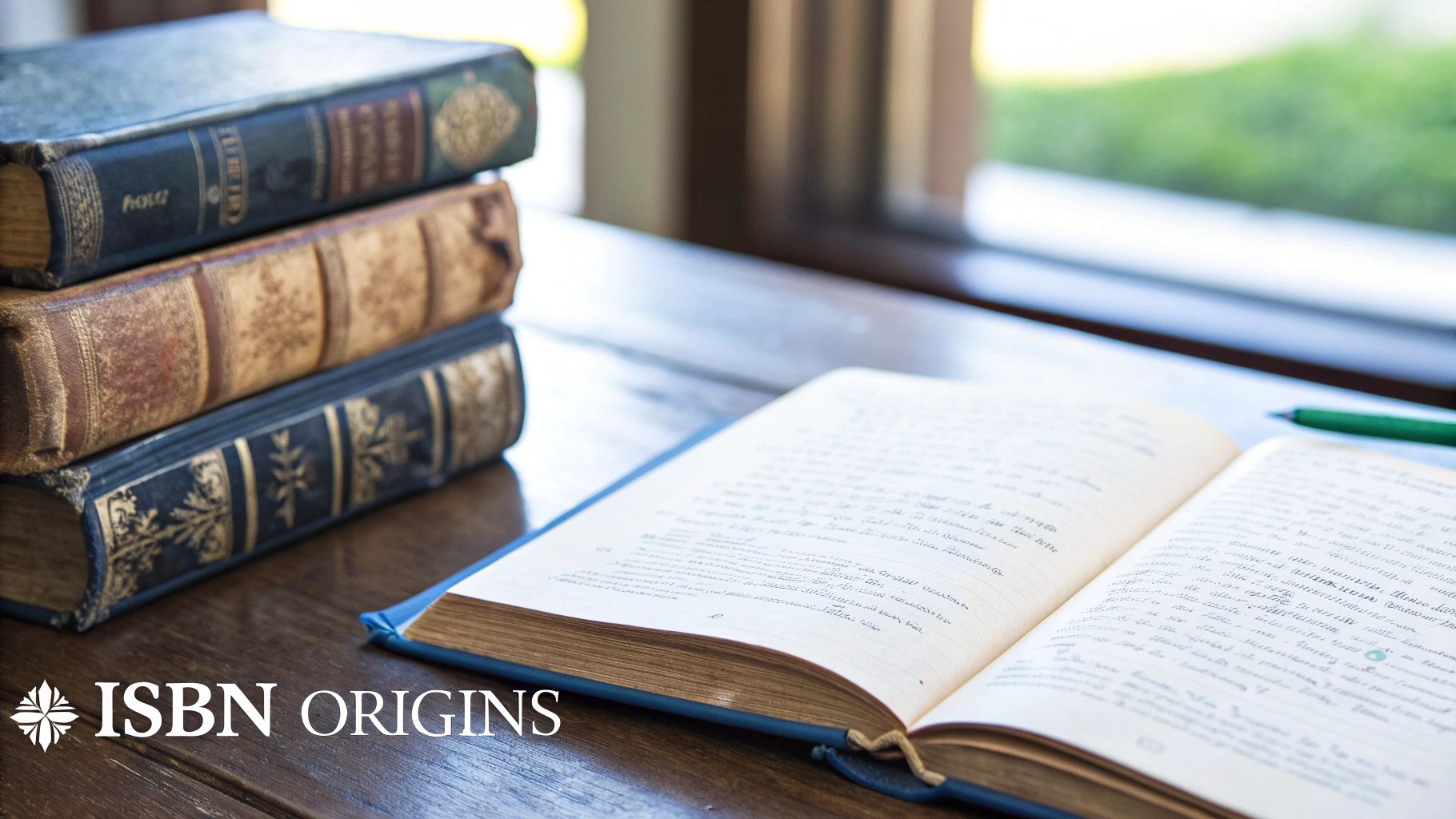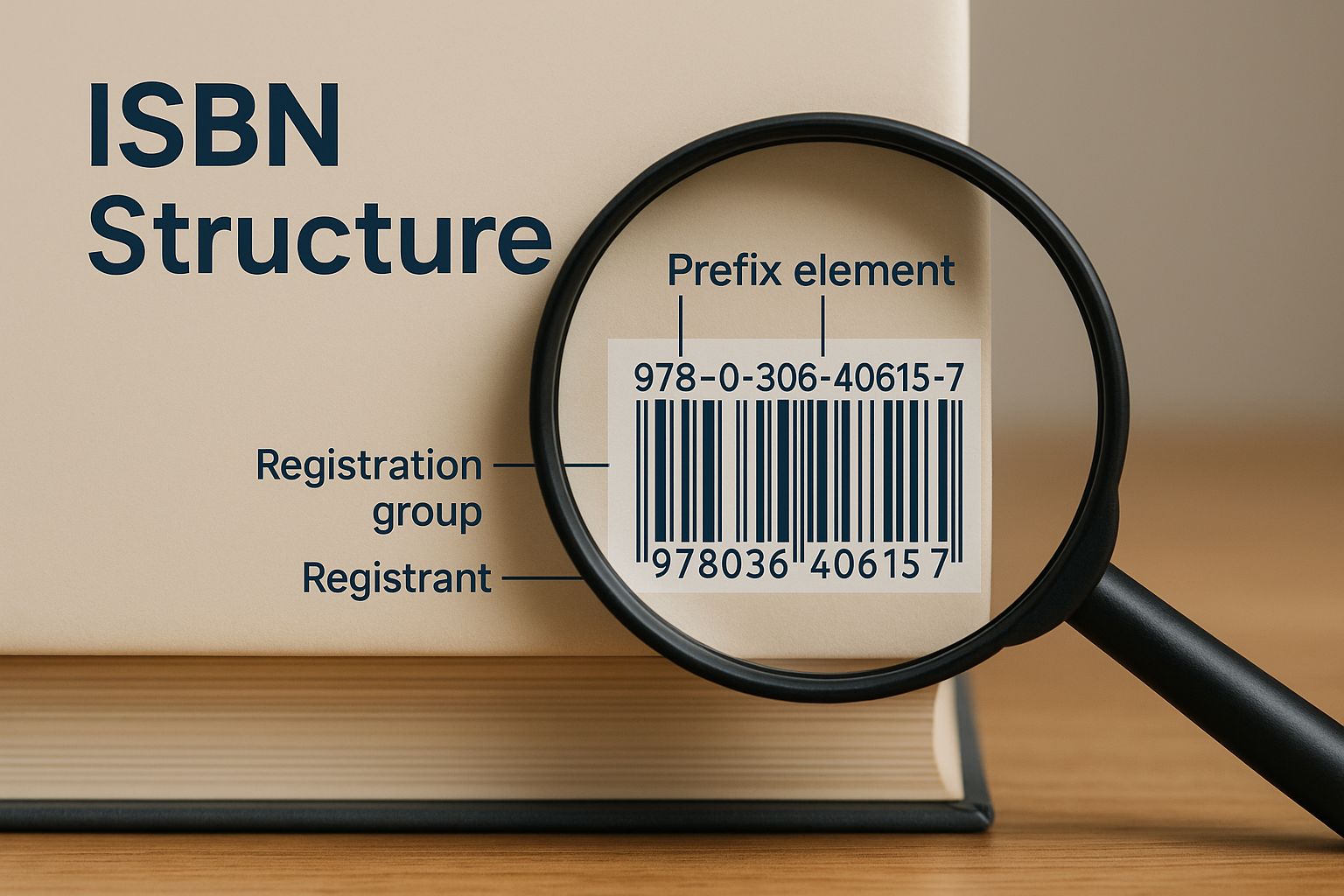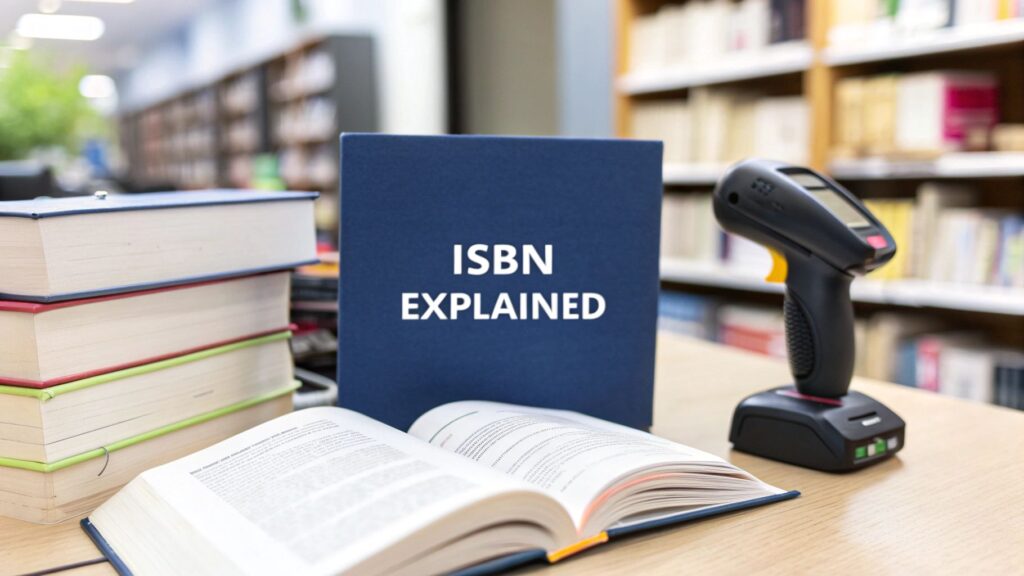Let's cut straight to the point. An ISBN (International Standard Book Number) is your book's unique fingerprint in the global marketplace. Think of it like a product's barcode or a car's VIN—it’s a universal identifier that allows publishers, bookstores, libraries, and online retailers to track and manage your book efficiently.
This number is your book's passport to the world.
Unpacking The Meaning Of An ISBN

So, what does this actually mean for you as an author? The ISBN system was created to standardize how books are identified across the entire supply chain. It’s a 13-digit code assigned to one specific edition and format of a book, making sure everyone from the printer to the final reader is talking about the same product.
While you don't legally need an ISBN just to write or print a book, it becomes absolutely essential the moment you decide to sell it. Without one, your book is practically invisible to the commercial world. Major retailers like Amazon and Barnes & Noble, along with distributors and libraries, depend on this number to manage inventory, place orders, and track sales.
Your Book’s Commercial Identity
Think of an ISBN as your book’s official entry into the global marketplace. It connects your title to a wealth of metadata that every retailer needs, including:
- The title and author: The most basic identifiers of the work and who created it.
- Publisher information: Specifies who owns the publishing rights for that specific edition.
- Physical properties: Details like the trim size, page count, and binding type (paperback, hardcover, etc.).
This data gets logged into huge industry databases, which is how your book becomes discoverable. An ISBN tells everyone that your book is a professional product, ready for sale. It’s one of the core parts of a book diagram you'll see on the back cover, usually right near the barcode.
An ISBN ensures that when a customer in another country orders your book, they receive the exact edition you published—not a different version from another publisher. It eliminates confusion and streamlines global commerce.
The Surprising History of the ISBN System

To really get what an ISBN is, you have to rewind to the 1960s. Imagine a world without computers managing inventory. For bookstores and publishers, ordering a specific book was a complete mess. Without a universal code, simply identifying the correct title, let alone the right edition or format, was a chaotic, error-prone headache.
This all started to change thanks to a single British retailer. In 1965, the massive bookseller WH Smith decided to computerize its warehouse. This was a huge undertaking, and they quickly realized they needed a standardized way to track every single book in their system. This one business need sparked the creation of the Standard Book Number (SBN), a 9-digit code that finally brought some order to the UK's book trade.
The SBN worked so well that it didn't take long for the rest of the world to notice. To handle the growing international demand, the system was expanded into the 10-digit International Standard Book Number (ISBN) and was formally adopted as an international standard in 1970. The official ISBN history page offers a great look back at how the system celebrated its 50th anniversary.
The Evolution to 13 Digits
But the story doesn't stop there. The 10-digit ISBN was the gold standard for decades, but as retail became more globalized, a new problem emerged. Most other consumer products used a 13-digit barcode system called the EAN (European Article Number). Books, with their unique system, were the odd ones out, causing inefficiencies for any retailer selling more than just books.
To sync up with global retail standards, the entire system got an overhaul. On January 1, 2007, the ISBN officially grew from 10 to 13 digits, making it fully compatible with the EAN barcode system you see on just about every other product.
This wasn't just a matter of tacking on three extra numbers. It was a move that plugged the book world directly into the modern supply chain. Suddenly, a barcode scanner anywhere on the planet could recognize a book just as easily as it could a box of cereal. This history shows that the ISBN is far more than a simple number—it’s the quiet invention that made the modern book industry possible.
Decoding the 13 Digits of Your Book's ISBN
At first glance, an ISBN might just look like a long, random number on the back of a book. But it’s actually a carefully constructed code, a kind of birth certificate for your book that tells a specific story. Each cluster of digits reveals something important about its origin, publisher, and edition.
Think of it as a book's unique fingerprint in the global marketplace. Understanding the anatomy of an ISBN means breaking it down into five key parts.
This infographic gives a great visual overview of how those parts fit together.

As you can see, every segment provides a specific piece of information, turning a simple string of numbers into a powerful identifier.
The Five Elements of an ISBN
Every modern 13-digit ISBN is made up of five distinct elements, usually separated by hyphens for readability. While the length of the middle sections can change, their sequence is always the same.
The whole system is designed to pack a ton of information into one scannable code. It starts with a global product prefix, then narrows down to the book's language region, its publisher, the specific title and format, and finally, a single digit to make sure the whole code is correct.
Let's dissect a real-world example: 978-1-942556-02-1.
The table below breaks down what each part of that ISBN tells us.
Anatomy Of A 13-Digit ISBN
| Part Name | Example Digits | What It Identifies |
|---|---|---|
| Prefix Element | 978 | Identifies the product as a book. It's always 978 or 979. |
| Registration Group | 1 | The country or language region. For example, 0 and 1 are for English-speaking areas like the US/UK. |
| Registrant (Publisher) | 942556 | The specific publisher or imprint. Larger publishers have shorter numbers here. |
| Publication Element | 02 | The specific book title and its format (e.g., hardcover vs. paperback). |
| Check Digit | 1 | A final digit calculated by a formula to verify the entire number is valid and has no errors. |
This structure ensures that every single book format—from your paperback novel to the audiobook version—gets its own unique identifier, preventing any confusion in the supply chain. You can take a closer look at the history and rules in this examination of the International Standard Book Number.
How to Get an ISBN for Your Book
Getting an ISBN for your book isn't complicated, but it does start with a big decision about your long-term goals as an author. The very first step is finding your country's official ISBN agency.
For writers in the United States, that's a company called Bowker, and you'll get your numbers through their MyIdentifiers website.
Think of these agencies as the official source. When you buy an ISBN directly from them, you are listed as the publisher of record. This is a huge deal because it gives you total control over where and how your book is sold, on any platform, forever.
Here's what the official Bowker MyIdentifiers homepage looks like. This is where US authors need to go.
Going straight to the source like this is the only way to be sure you're getting a legitimate ISBN that gives you full publishing rights.
Choosing Your Purchase Option
Once you're on your country's official ISBN site, you'll see a couple of choices: buy just one ISBN, or buy them in a block. A single ISBN makes sense if you know, without a doubt, that you'll only ever publish one version of one book (like a paperback and nothing else).
But buying in bulk is where the real savings are. A block of 10 ISBNs usually costs a fraction of what you'd pay buying two or three separately. Remember, every single format—paperback, hardcover, ebook, audiobook—needs its own unique ISBN. So, if you're planning multiple formats or have more books in you, a block is a smart investment.
The "Free" ISBN Trap
You've probably seen self-publishing platforms like Amazon KDP offer a "free" ISBN. It sounds like a great deal, but there’s a massive string attached.
When you accept a free ISBN from a platform, that platform—not you—becomes the publisher of record. This permanently ties your book to their service, meaning you cannot use that ISBN to sell your book on other retail sites or through different distributors.
This is a critical trade-off you need to understand. If you want total freedom and control over your book and your author brand, the only way forward is to purchase your own ISBN. This choice really gets to the heart of what it means to be an independent author.
If you're weighing your options, our detailed guide on where to buy an ISBN breaks down all the best sources.
One of the biggest questions I hear from authors is, "Do I need a new ISBN for this?" It can feel a little confusing at first, but the logic behind it is pretty straightforward. It all boils down to a single guiding principle: a unique ISBN identifies a unique product.
Think of it like this: your ISBN doesn't just represent your story. It represents a very specific version of that story. When a bookstore wants to order the paperback, they need a number that points directly to that physical book—not the ebook, not the hardcover, and not the audiobook.
One Book, Many Formats
The most fundamental rule is that every format needs its own unique ISBN. If you're planning to publish your masterpiece in a few different ways, you'll need to assign a separate ISBN to each one.
- Paperback: Gets its own ISBN.
- Hardcover: Needs a different ISBN from the paperback.
- Ebook (EPUB, etc.): Your digital version requires a unique number, completely separate from any print edition.
- Audiobook: This format also gets its own dedicated ISBN.
This clear separation is what makes the entire global book supply chain work, from giant distributors down to your local indie bookstore. It’s all about accurate ordering and inventory.
When Content Changes Demand a New Number
It's not just about the format. Sometimes, changes to the book itself are so significant that they create what the industry considers a brand-new product. When this happens, you guessed it—you need a new ISBN.
You'll need to get a new ISBN if you:
- Publish a New Edition: Releasing a second edition with major updates? Maybe you added a few new chapters, wrote a new foreword, or did a massive overhaul of the text. That's a new edition, and it needs a new number to distinguish it from the original.
- Change the Trim Size: If you decide to change your book's physical dimensions—say, going from a 6×9 to a 5×8—you've created a new physical product. That requires a new ISBN.
- Change the Title: This one's a biggie. A title change is a fundamental update that absolutely requires a new ISBN. Not getting one would cause a huge amount of confusion in bookstore catalogs and online listings.
When You Can Stick With Your Original ISBN
Just as important is knowing when you don't need to spend money on a new ISBN. Minor tweaks and cosmetic updates don't create a new product, so you can keep the number you already have.
A new ISBN isn't necessary for simple reprints or marketing changes. Things like fixing typos or refreshing the cover art don't change the core product that readers are buying.
For example, you do not need a new ISBN for these kinds of changes:
- Fixing a handful of typos or grammatical mistakes.
- Changing the price of your book.
- Updating the cover design (as long as the title and content remain the same).
Getting this right from the start saves you a lot of headaches and potential costs down the road. When you're ready to move forward, you can learn more about how to get an ISBN for your book and get the process started.
Answering Your Top ISBN Questions
Once you get the basics down, the real-world questions start popping up. Let's tackle some of the most common ones that authors face as they get ready to hit "publish."
Can I Reuse an ISBN for a New Book?
That’s a firm no. Think of an ISBN like a Social Security Number, but for your book. Each number is permanently assigned to one specific title, in one specific format (like paperback or ebook).
If you were to reuse an ISBN, it would be like giving two different people the same Social Security Number—it would cause a logistical nightmare for bookstores, libraries, and distributors trying to track and order the right book. Every new book, and every new edition of an old book, needs its very own ISBN.
Does My Ebook Need an ISBN?
Yes, if you want to sell it everywhere. It's true that Amazon will assign its own internal number, called an ASIN, if you sell exclusively through their Kindle Direct Publishing (KDP) platform.
But if you want to sell your ebook "wide"—meaning on other platforms like Apple Books, Kobo, and Barnes & Noble—you absolutely need your own ISBN.
Giving your ebook its own ISBN is key to maximizing your reach. It allows your book to be properly listed and tracked across dozens of different online stores, not just one.
What's the Deal with 10-Digit vs. 13-Digit ISBNs?
The main difference is simply age. Before 2007, the industry standard was a 10-digit ISBN. But as the number of published books exploded, the system needed more capacity.
So, on January 1, 2007, the entire system switched over to the 13-digit format to expand the pool of available numbers and better align with global product barcodes. Any book published since then has a 13-digit ISBN, which is now the universal standard.
Just How Many ISBNs Are Out There?
The numbers are pretty staggering and give you a sense of the scale of global publishing. In 2020 alone, the U.S. issued over 3.9 million new ISBNs. To date, more than 39 million have been registered in the U.S. overall, which really drives home why a unique identifier for every single book is so essential. You can dig into even more global ISBN usage and statistics if you're curious.
Without the ISBN system, the book world would be pure chaos.
Ready to get your own official ISBN and see your manuscript become a professionally published book? BarkerBooks takes care of the whole process for you, from editing and cover design to global distribution. We manage the technical side so you can stay focused on your writing. Learn more about our all-inclusive publishing packages and take the next step on your author journey today.
